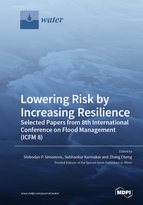Lowering Risk by Increasing Resilience: Selected Papers from 8th International Conference on Flood Management (ICFM 8)
A special issue of Water (ISSN 2073-4441). This special issue belongs to the section "Hydrology".
Deadline for manuscript submissions: closed (28 February 2022) | Viewed by 53314
Special Issue Editors
Interests: water management; systems analysis; complexity; risk; resilience; hydrology
Special Issues, Collections and Topics in MDPI journals
Interests: analysis of hydro-climatic extremes; floodplain hydrology and management; uncertainty modeling and decision science
Special Issues, Collections and Topics in MDPI journals
Interests: eco-hydrology; flooding management; flood resilience; water management
Special Issues, Collections and Topics in MDPI journals
Special Issue Information
Dear Colleagues,
The International Conference on Flood Management (ICFM), hosted every 3 years, offers a platform to discuss a range of flood-related issues and realize significant change in a multidisciplinary, multisectoral area. The eighth International Conference on Flood Management (ICFM8) under the title “Lowering Risk by Increasing Resilience” was planned for August 17–19, 2020 at the University of Iowa, Iowa City, Iowa, USA. The main objective of ICFM8 is to provide a unique opportunity to exchange ideas and experiences on a range of issues that affect flood management, particularly the need to build resilience into future planning.
Unfortunately, due to extraordinary circumstances, we had to cancel the in-person ICFM8. However, the ICFM decided to do their best to continue and use as much as possible of the work toward ICFM8. One of our main follow-up activities is the publication of a Water Journal Special Issue (or issues) from submissions to ICFM8.
The Special Issue/s will identify key concerns and significant challenges of the future as currently perceived by researchers, industry, policymakers, and other flood management stakeholders. The main themes to be addressed include: science and technology for flood risk management; handling data and information for flood risk management; flood disaster prevention, mitigation, and adaptation; flood preparedness, response, and recovery; flood decision-making, policy, and governance; and flood resilience.
All conference submissions will be published in the conference book of abstracts, and selected papers will be considered for publication in this Special Issue. All the papers considered for publication in the Special Issue will be subject to the review process according to the journal requirements.
Prof. Dr. Slobodan P. Simonovic
Prof. Dr. Subhankar Karmakar
Prof. Dr. Zhang Cheng
Guest Editors
Manuscript Submission Information
Manuscripts should be submitted online at www.mdpi.com by registering and logging in to this website. Once you are registered, click here to go to the submission form. Manuscripts can be submitted until the deadline. All submissions that pass pre-check are peer-reviewed. Accepted papers will be published continuously in the journal (as soon as accepted) and will be listed together on the special issue website. Research articles, review articles as well as short communications are invited. For planned papers, a title and short abstract (about 100 words) can be sent to the Editorial Office for announcement on this website.
Submitted manuscripts should not have been published previously, nor be under consideration for publication elsewhere (except conference proceedings papers). All manuscripts are thoroughly refereed through a single-blind peer-review process. A guide for authors and other relevant information for submission of manuscripts is available on the Instructions for Authors page. Water is an international peer-reviewed open access semimonthly journal published by MDPI.
Please visit the Instructions for Authors page before submitting a manuscript. The Article Processing Charge (APC) for publication in this open access journal is 2600 CHF (Swiss Francs). Submitted papers should be well formatted and use good English. Authors may use MDPI's English editing service prior to publication or during author revisions.
Keywords
- Flood
- Disasters
- Risk
- Resilience








